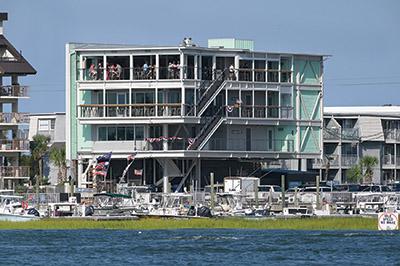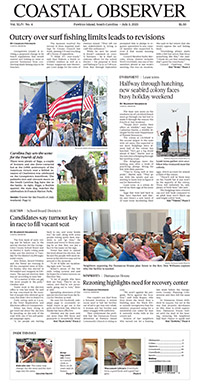Land use
Marlin Quay rezoning suit reaches Supreme Court

Eight years after a store and restaurant were torn down at Marlin Quay Marina attorneys argued before the state Supreme Court whether Georgetown County’s approval of a new, larger building violated state and local law.
If the county was not in violation, then its approval created a “taking” for which the owner of the neighboring Gulfstream Café should be compensated, Simon Bloom, attorney for Gulfstream told the court at a hearing last week.
An appraiser testified during a trial in Circuit Court in 2022 that the approval of a new Marlin Quay restaurant reduced the value of the Gulfstream property from $1.85 million to $90,000.
If the high court finds that the county failed to follow its own ordinance in approving the Marlin Quay building, it should send the case back to Circuit Court to determine the next step.
Henrietta Golding, attorney for the county, said the approval was valid and there is no reason to compensate Gulfstream.
At issue is an easement that gives Gulfstream access to 62 parking spaces in the Marlin Quay
“planned development” zoning district, which was created in 1982. Gulfstream argues that increased demand for parking from the new Marlin Quay restaurant will hurt its business.
“There is no loss of 62 parking spaces. That is unfounded,” Golding said. “That is the fundamental basis of Gulfstream’s appeal. And that fundamental basis is false.”
Palmetto Industrial Development, whose principal is Mark Lawhon, bought the marina in 2014. When he tore down the marina store and restaurant in November 2016, Gulfstream, part of a restaurant group whose principal is Jerry Greenbaum, went to court to block the county’s approval of a new facility, which county staff had approved as a minor change to the planned development.
Although the decision was upheld by the county Board of Zoning Appeals, Palmetto agreed to resubmit its plan as a major change requiring review by the Planning Commission, a public hearing and three readings from County Council.
The new facility was designed by SGA Architecture, a firm owned by then-County Council Member Steve Goggans. His role and his appearance at the zoning appeal led to a warning and fine from the state Ethics Commission.
Bloom argued that Goggans’ participation “is really the explanation for why we have such an upside down government regulation.”
Goggans did not participate in the next two iterations of the Marlin Quay zoning change, known in court documents at 2.0 and 3.0.
After the county approved 2.0 in 2018, a Circuit Court judge ruled in a separate suit brought by Gulfstream against Palmetto over the easement that the new building had to fit within the footprint of the old building.
Version 3.0 reduced the building dimensions to comply with the judge’s ruling. It was approved by the county in 2019. In all versions, the new building had 4,596 square feet of heated space and 110 seats in the restaurant.
Gulfstream filed suit. It eventually dropped the other six council members from its complaint, but kept Goggans as an individual defendant and in his official capacity.
Last year, Circuit Court Judge R. Kirk Griffith upheld the county’s decision. He found that Gulfstream’s constitutional rights were not violated and that it had failed to show that it had lost “all economically beneficial use” of its property.
Gulfstream appealed to the Supreme Court based on the constitutional issues.
“What we find ourselves coming back to is the age-old conflict, the tension between the inalienable rights of private property and the governmental interest in regulating property,” Bloom said.
In the case of Marlin Quay, “the scale is tipped infinitely in one direction because there’s zero on the side of governmental interest,” he said.
Chief Justice John Kittredge pointed out that Gulfstream has a “non-exclusive easement” for parking. “How does that morph into the property right that triggers substantive due process protection?” he asked.
The easement is what gives the Gulfstream property value, since the planned development limits the property’s use to a restaurant, Bloom said.
He added that “a fatal error in the trial court’s opinion” was that it limited its focus to the easement.
“How about the other restaurant owner’s property owner’s rights to use it’s property?” Justice George James asked.
“That is sacrosanct,” Bloom said. “However, your honor, that does not extend to being able to build a 10,000 square foot new restaurant where a 4,500 square foot restaurant once existed.”
He told the court that the county’s zoning ordinance requires 170 parking spaces for the larger building. Only 62 exist.
Bloom agreed that the existing buildings didn’t meet the rule, but said they were a legal non-conforming use. A change such as the one made for Marlin Quay required they be brought into compliance.
“There’s an opportunity to fix it, but one can not make it worse,” he said.
Justice D. Garrison Hill asked why the planned development zoning wasn’t allowed to have its own set of rules.
Bloom replied that the parking standards apply to all zoning districts.
James asked what Bloom’s argument would be if Goggans had not been involved and if the easement had been more explicit.
By increasing the size of the Marlin Quay restaurant and increasing the nonconformity “that’s probably enough on its own to render the decision arbitrary, capricious and unreasonable,” Bloom said. “The parking count itself, your honor, is really all one needs when you combine that with the fact that there is zero governmental benefit done by passing this regulation. When you combine those two things, it is a slam dunk violation of substantive due process.”
Golding started her argument by correcting Bloom. “He made many misstatements of fact,” she said.
Among those, she said, was claiming that Goggans came up with a way to justify the larger building without an increase in parking by counting only the heated square footage. That was actually proposed by the architect who first worked on the Marlin Quay project.
The parking requirement was specified in the 1982 planned development, Golding said. It also outlined the other uses, including the marina’s store and restaurant.
“While Mr. Bloom wants to say it was a bait shop, it never was. It was a retail store. It was a full restaurant with 110 seats,” she said.
State law allows planned developments as “variations of the zoning,” Golding said. “The plan was adopted in 1982. It’s not as sophisticated as today, as the testimony has shown, but it’s the plan.”
Kittredge questioned the use of heated square footage in assessing the parking. “It seems like you’re artificially changing the reality,” he said.
Since the new building had to be elevated to meet federal flood regulations, it needed more outside area, Golding said.
There was a government interest in allowing the existing business to continue, “not increasing its operations, but using the same operations that were in existence,” Golding said. “This was a reasonable way.”
Hill asked how the change to the planned development furthered the goals of the county comprehensive plan as the law requires.
The marina offers services to the public and the plan calls for providing access to the beach and waterways.
“So whatever further development furthers the plan, is that the argument?” Hill asked.
“That benefits the public,” Golding added.
She also argued that Gulfstream failed to challenge Version 2.0 which actually increased the size of the restaurant. That became the planned development zoning for the property, Golding said.
Version 3.0 only brought the building footprint into compliance with a court order, a valid government action, she said.
On rebuttal, Bloom called that “a complete red herring.”
Amending the planned development “starts a whole new clock,” he said.
Golding closed her argument by citing testimony from the Gulfstream manager who was asked by Bloom during the trial if he was worried about the new restaurant “stealing his customers.” “Very,” was the response.
“This is about the competition,” Golding said. “There were no constitutional rights deprived.”
Golding also told the court that both restaurants have been operating for almost two years.
Bloom pointed out during his rebuttal that the restaurant operations were not part of the trial record.
He called Golding’s comment “wholly inappropriate, completely improper and should not, shall not, cannot be considered with respect to this case.”
“What’s your remedy?” Kittredge asked.
If it’s a violation, remand the case. If not, grant compensation for a taking.
Or, “if they’re hanging their hat on this 110, then they need to live with 110,” Bloom said, referring to the Marlin Quay seating and adding that the fire marshal’s limit for the building is 350.
“Wonderful arguments on both sides,” Kittredge said.




